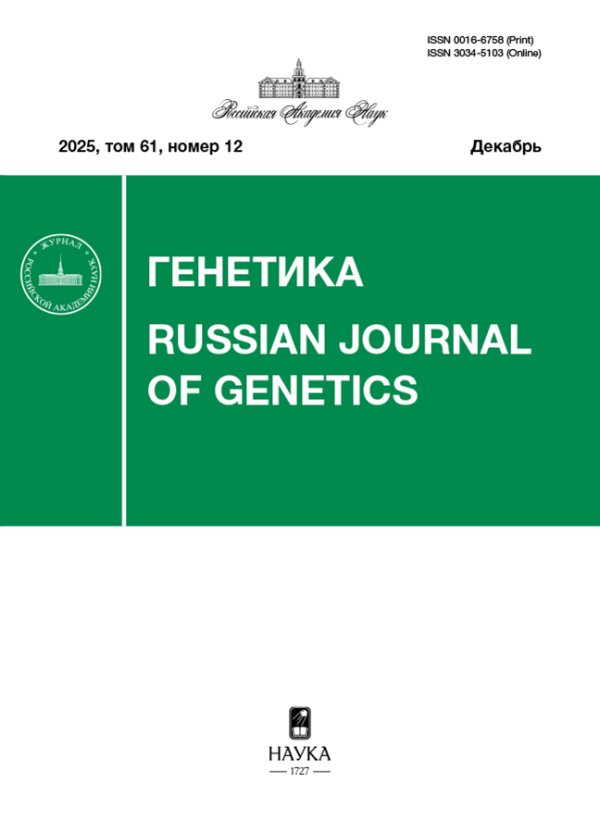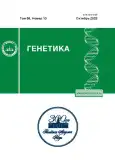Исследование ассоциации полиморфных вариантов rs2295080 и rs1883965 гена MTOR с развитием и течением саркоидоза легких
- Авторы: Малышева И.Е.1, Топчиева Л.В.1, Тихонович Э.Л.2
-
Учреждения:
- Институт биологии – обособленное подразделение Федерального государственного бюджетного учреждения науки Федерального исследовательского центра “Карельский научный центр Российской академии наук”
- Республиканская больница им. В.А. Баранова
- Выпуск: Том 59, № 10 (2023)
- Страницы: 1165-1170
- Раздел: ГЕНЕТИКА ЧЕЛОВЕКА
- URL: https://journals.rcsi.science/0016-6758/article/view/140391
- DOI: https://doi.org/10.31857/S0016675823100090
- EDN: https://elibrary.ru/ZVGTIM
- ID: 140391
Цитировать
Полный текст
Аннотация
Цель исследования – изучение ассоциации полиморфных вариантов rs2295080 и rs1883965 гена MTOR с риском развития саркоидоза легких. В исследование включено 253 человека (122 больных с диагнозом морфологически верифицированный саркоидоз с поражением легких (средний возраст – 41.00 ± 12.56 года) и 131 здоровый человек (контрольная группа) (средний возраст – 44.00 ± 14.23 года)). В исследование включены жители Республики Карелия. В исследуемых группах проанализировано распределение аллелей и генотипов полиморфных маркеров rs2295080 и rs1883965 гена MTOR. Генотипирование проводили с помощью ПЦР-ПДРФ анализа. Уровень транскриптов гена MTOR в лейкоцитах периферической крови (ЛПК) больных саркоидозом легких и здоровых людей оценивали с помощью ПЦР в режиме реального времени. Установлено статистически значимое повышение уровня экспрессии мРНК гена MTOR в ЛПК больных саркоидозом легких по сравнению с контрольной группой (р = 0.007). Отмечено снижение количества транскриптов указанного гена у пациентов, получающих терапию по сравнению с пациентами без терапии (p = 0.025). Cтатистически значимых различий в распределении частот аллелей и генотипов по полиморфным маркерам rs2295080 и rs1883965 гена MTOR в группе больных саркоидозом легких и в контрольной группе не установлено (χ2 = 0.196, d.f. = 1, p = 0.658 и χ2 = 0.637, d.f. = 2, p = 0.728) и (χ2 = 0.034, d.f. = 1, p = = 0.855 и χ2 = 0.051, d.f. = 2, p = 0.975) соответственно. Повышенный уровень экспрессии гена MTOR в лейкоцитах периферической крови больных саркоидозом легких может свидетельствовать о вовлечении указанного гена в патогенез данного заболевания. Полиморфные маркеры rs2295080 и rs1883965 гена MTOR не связаны с риском развития саркоидоза легких. Вероятно, повышение уровня экспрессии гена MTOR у больных саркоидозом легких обусловлено развитием воспаления.
Ключевые слова
Об авторах
И. Е. Малышева
Институт биологии – обособленное подразделение Федерального государственного бюджетного учреждения науки Федерального исследовательского центра “Карельский научный центр Российской академии наук”
Автор, ответственный за переписку.
Email: i.e.malysheva@yandex.ru
Россия, 185910, Петрозаводск
Л. В. Топчиева
Институт биологии – обособленное подразделение Федерального государственного бюджетного учреждения науки Федерального исследовательского центра “Карельский научный центр Российской академии наук”
Email: i.e.malysheva@yandex.ru
Россия, 185910, Петрозаводск
Э. Л. Тихонович
Республиканская больница им. В.А. Баранова
Email: i.e.malysheva@yandex.ru
Россия, 185019, Петрозаводск
Список литературы
- Sarbassov D.D., Ali S.M., Kim D.H. et al. Rictor, a novel binding partner of mTOR, defnes a rapamycin-insensitive and raptor-independent pathway that regulates the cytoskeleton // Curr. Biol. 2004. V. 14. P. 1296–1302. https://doi.org/10.1016/j.cub.2004.06.054
- Huang S. mTOR signaling in metabolism and cancer // Cells. 2020. V. 9. № 10. https://doi.org/10.3390/cells9102278
- Linke M., Pham H.T., Katholnig K. et al. Chronic signaling via the metabolic checkpoint kinase mTORC1 induces macrophage granuloma formation and marks sarcoidosis progression // Nat. Immunol. 2017. V. 18. № 3. P. 293–302. https://doi.org/10.1038/ni.3655
- Шмелёв Е.И. Саркоидоз // Атмосфера, пульмонология и аллергология. 2004. № 2. С. 3–10.
- Малышева И.Е., Тихонович Э.Л., Олейник Е.К. и др. Поляризация макрофагов при саркоидозе // Мед. иммунология. 2021. Т. 23. № 1. P. 7–16. https://doi.org/10.15789/1563-0625-MPI-2083
- Пархитько А.А., Фаворова О.О., Хабибуллин Д.И. и др. Киназ аmTOR: регуляция, роль в поддержании клеточного гомеостаза, развитии опухолей и старении // Биохимия. 2014. Т. 79. № 2. С. 128–143.
- Jhanwar-Uniyal M., Amin A.G., Cooper J.B. Discrete signaling mechanisms of mTORC1 and mTORC2: Connected yet apart in cellular and molecular aspects // Adv. Biol. Regul. 2017. V. 64. P. 39–48. https://doi.org/10.1016/j.jbior.2016.12.001
- Locke L., Schlesinger L., Crouser E. Current sarcoidosis models and the importance of focusing on the granuloma // Front. Immunol. 2020. V. 11. https://doi.org/10.3389/fimmu.2020.01719
- Pouché L., Stojanova J., Pierre Marquet P., Picard N. New challenges and promises in solid organ transplantation pharmacogenetics: The genetic variability of proteins involved in the pharmacodynamics of immunosuppressive drugs // Pharmacogenomics. 2016. V. 17. № 3. P. 277–296. https://doi.org/10.2217/pgs.15.169
- Xu M., Gao Y., Yu T. Functional promoter rs2295080 T>G variant in MTOR gene is associated with risk of colorectal cancer in a Chinese population // Biomedicine & Pharmacotherapy. 2015. V. 70. P. 28–32. https://doi.org/10.1016/j.biopha.2014.12.045
- Lan J., Zhu Y., Rao J. et al. MTOR gene polymorphism may be associated with microscopic polyangiitis susceptibility in a Guangxi population of China // Gene. 2023. V. 854. https://doi.org/10.1016/j.gene.2022.147101
- Min Z., Mi Y., Lv Z. et al. Associations of Genetic Polymorphisms of mTOR rs2295080 T/G and rs1883965 G/A with Susceptibility of Urinary System Cancers // Dis. Markers. 2022. V. 17. https://doi.org/10.1155/2022/1720851
- Paterno J., Koskela A., Hyttinen J. Autophagy genes for wet age-related macular degeneration in a finnish case-control study // Genes. 2020. V. 11. P. 1318. https://doi.org/10.3390/genes11111318
- Li H., Liu Y., Huang J. et al. Association of genetic variants in lncRNA GAS5/miR-21/mTOR axis with risk and prognosis of coronary artery disease among a Chinese population // J. Clin. Lab. Anal. 2020. V. 34. № 10. https://doi.org/10.1002/jcla.23430
- Baughman R.P., Culver D.A., Judson M.A. A concise review of pulmonary sarcoidosis // Am. J. Respir. Crit. Care Med. 2011. V. 183. № 5. P. 573–581. https://doi.org/10.1164/rccm.201006-0865CI
- Bizhani F., Hashemi M., Danesh H. et al. Association between single nucleotide polymorphisms in the PI3K/AKT/mTOR pathway and bladder cancer risk in a sample of Iranian population // EXCLI J. 2018. V. 17. P. 3–13. https://doi.org/10.17179/excli2017-329
- Клинические рекомендации по саркоидозу Минздрава России. М., 2022. С. 30–31.
- Pinto J., Dias V., Zoller H. et al. Hepcidin messenger RNA xpression in human lymphocytes // Immunology. 2010. V. 130. № 2. P. 217–230. https://doi.org/10.1111/j.1365-2567.2009.03226.x
- Корнилов Д.О., Тряпицын М.А., Гребнев Д.Ю. MTOR: сигнализация, регуляция, влияние на метаболизм, роль в регуляции продолжительности жизни и опухолевого роста // Изв. Коми научного центра УрО РАН. 2021. № 5. С. 104–115. https://doi.org/10.19110/1994-5655-2021-5-104-115
- Rubie C., Zimmer J., Lammert F. MicroRNA-496 and mechanistic target of rapamycin expression are associated with type 2 diabetes mellitus and obesity in elderly people // Ann. Nutr. Metab. 2019. V. 74. № 4. P. 279–286. https://doi.org/10.1159/000499576
- Rahtes A., Geng S., Lee C., Li L. Cellular and molecular mechanisms involved in the resolution of innate leukocyte inflammation // J. Leukoc. Biol. 2018. V. 104. № 3. P. 535–541. https://doi.org/10.1002/JLB.3MA0218-070R
- Li Y., Zhao P., Yue X. et al. Association of mTOR polymorphisms with cancer risk and clinical outcomes: a meta-analysis // PLoS One. 2014. V. 9. № 5. https://doi.org/10.1371/journal.pone.0097085
- Cao Q., Ju X., Li P. A functional variant in the MTOR promoter modulates its expression and is associated with renal cell cancer risk // PLoS One. 2012. V. 7. № 11. https://doi.org/10.1371/journal.pone.0050302
- Saravani M., Shahraki-Ghadimi H., Maruei-Milan R. et al. Effects of the mTOR and AKT genes polymorphisms on systemic lupus erythematosus risk // Mol. Biol. Rep. 2020. V. 47. № 5. P. 3551–3556. https://doi.org/10.1007/s11033-020-05446-y
- Shao J., Li Y., Zhao P. et al. Association of mTOR polymorphisms with cancer risk and clinical outcomes: A meta-analysis // PLoS One. 2014. V. 9. № 5. https://doi.org/10.1371/journal.pone.0097085
- Zining J., Lu X., Caiyun H., Yuan Y. Genetic polymorphisms of mTOR and cancer risk: A systematic review and updated meta-analysis // Oncotarget. 2016. V. 7. № 35. P. 57464–57480. https://doi.org/10.18632/oncotarget.10805
- Wang M., Ma S.J., Wu X.Y. et al. Impact of mTOR gene polymorphisms and gene-tea interaction on susceptibility to tuberculosis // J. Clin. Cases. 2020. V. 8. № 19. P. 4320–4330. https://doi.org/10.12998/wjcc.v8.i19.4320
- Николаев А.В., Утехин В.И., Чурилов Л.П. Сравнительная этио-эпидемиологическая характеристика туберкулеза и саркоидоза легких: классические и новые представления // Педиатрия. 2020. Т. 11. № 5. С. 37–50. https://doi.org/10.17816/PED11537-50
- He J., Wang M., Qiu L. et al. Genetic variations of mTORC1 genes and risk of gastric cancer in an Eastern Chinese population // Mol. Carcinog. 2013. V. 52. Suppl. 1. P. E70-9. https://doi.org/10.1002/mc.22013
Дополнительные файлы











